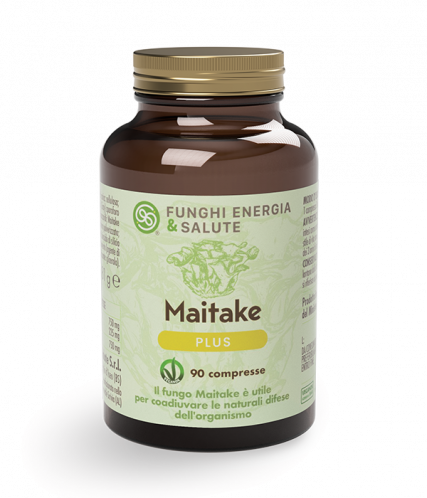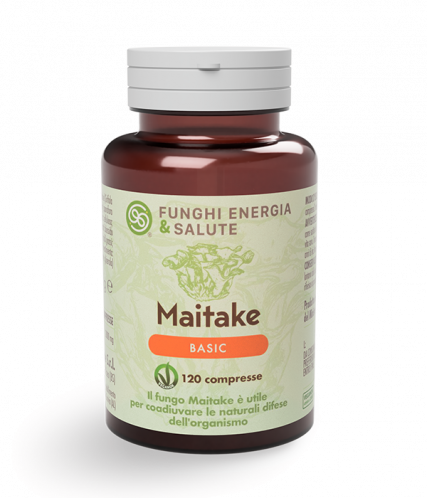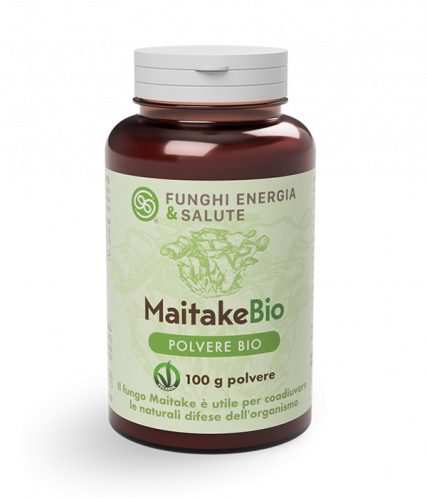Certified Natural products veganOK
030 9881073 Monday to Friday from 09:00 to 17:30


to get immediately a discount code
on your first purchase
Maitake
- Home
- Maitake
Maitake (Grifola frondosa) is highly appreciated as a fat burner: scientific research documents its usefulness in weight loss diets. Furthermore, Maitake inhibits the production of adipose tissue because it blocks some biochemical passages necessary for the formation of fat cells (Minamino et al., 2004 and 2008).
It is useful in metabolic diseases: it favors the use of fats for producing energy and consequently keeps the desire for sweets and carbohydrates under control.
As is well-known, the use of fats counteracts hypoglycaemia, which is the condition that triggers appetite. Some studies on diabetic patients have shown the positive effect of this Medicinal Mushroom, because it supports the activity of the pancreas, helps insulin production and reduces blood sugar, increasing use by the sugar cells in the blood (Manohar et al., 2002).
It also regulates the functions of the intestine and has an anti-inflammatory effect; for this reason it is useful in food intolerances and in case of irritable bowel syndrome (Lee et al., 2010).
Maitake is also a powerful hepatoprotector, capable of lowering elevated transaminases (ALT and ASP) (Lee et al., 2000).
The use of this Medicinal Mushroom also has a positive effect on prostate health; it reduces benign hyperplasia of the prostate and improves urinary flow (Boh and Berovic, 2007).
Used in Traditional Chinese Medicine, in the last fifteen years Maitake has gained worldwide fame thanks to its efficacy as an immunostimulant and anti-diabetic agent and its recognized ability to reduce adipose tissue.
The work of the Japanese Professor Nakai (Nakai et al., 1999) gave further stimulus to research, as demonstrated by the interesting works of his colleague Minamino (Minamino et al., 2004 and 2008) and the Korean group of Professor Jung.
Today, scientific interest in this Medicinal Mushroom has literally exploded, making it popular throughout East Asia, the United States, Canada and Northern Europe.
Mycology
Maitake (Grifola frondosa) grows mostly near tree stumps or under chestnut, beech and oak trees. The actual mushroom is made up of a mass of individual elements that grow side by side, forming a sort of "cluster". It grows in Japan, Asia, North America but also in Italy.
Maitake means "dancing mushroom", because it was said to make those who found it dance with joy: in China, during the Middle Ages, it had the same value as silver.
It is also very popular in cooking.
It contains beta-glucans, polysaccharides, terpenes, minerals, trace elements and vitamins. The presence of a compound called HPLC, useful in slimming diets is also of interest.
In detail:
- beta-glucans are powerful immunostimulants and antivirals (Nanba et al., 2000; Zhuang and Wasser, 2004; Lee et al., 2000);
- some beta-glucans (SX, factor X) and an alpha-glucan (MT) exert a useful hypoglycaemic effect (Zhuang and Wasser, 2004);
- HPLC inhibits the formation of adipose tissue;
- a hepatoprotective molecule extremely useful for liver health.
- Boh B, Berovic M. (2007): “Grifola frondosa (Dicks.: Fr.) SF Gray (Maitake mushroom): medicinal properties, active compounds, and biotechnological cultivation.” International Journal of medicinal mushrooms, 9(2): 89-108.
- Jung K, Kim IH, Han D. (2004): “Effect of medicinal plant extracts on forced swimming capacity in mice.” Journal of ethnopharmacology, 93(1): 75- 81. • Lee EW, He P, Kawagishi H, Sugiyama K. (2000): “Suppression of D-galactosamine-induced liver injury by mushrooms in rats.” Bioscience, biotechnology, and biochemistry, 64(9): 2001-2004.
- Lee JS, Park SY, Thapa D, Choi MK, Chung IM, Park YJ, Yong CS, Choi HG, Kim JA. (2010): “Grifola frondosa water extract alleviates intestinal inflammation by suppressing TNF-α production and its signaling.” Experimental molecular medicine, 42(2): 143-154.
- Manohar V, Talpur NA, Echard BW, Lieberman S, Preuss HG. (2002): “Effects of a water-soluble extract of Maitake mushroom on circulating glucose/insulin concentrations in KK mice.” Diabetes, Obesity and Metabolism, 4(1): 43-48.
- Minamino K, Yanaga Y, Masui H, Ohtsuru M. (2004): “Effects of a water- soluble bioactive factor from Grifola frondosa, the mushroom Maitake on adipocyte differentiation.” Food Science and Technology Research, 10(4): 416-419.
- Minamino K, Nagasawa Y, Ohtsuru M. (2008): “A water-soluble extract from Grifola frondosa, Maitake mushroom, decreases lipid droplets in brown adipocyte tissue cells. Journal of nutritional science and vitaminology, 54(6): 497- 500.
- Nanba H, Kodama N, Schar D, Turner D. (2000): “Effects of Maitake (Grifola frondosa) glucan in HIV-infected patients.” Mycoscience, 41(4): 293-295.
- Nakai R, Masui H, Horio H, Ohtsuru M. (1999): “Effect of M aitake (Grifola frondosa) water extract on inhibition of adipocyte conversion of C3H10T1/2B2C1 cells.” Journal of nutritional science and vitaminology, 45(3): 385-389.
- Zhuang C, Wasser SP. (2004): “Medicinal value of culinary-medicinal Maitake mushroom Grifola frondosa (Dicks.:Fr.) SF Gray (Aphyllophoromycetideae). ” International Journal of Medicinal Mushrooms, 6: 287–313.




